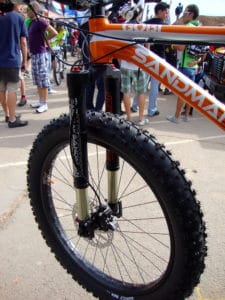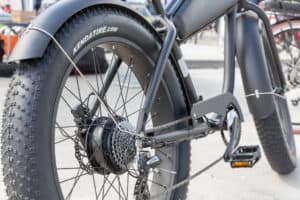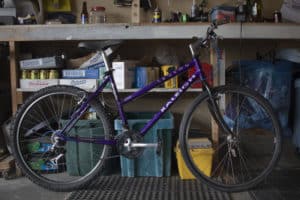Bike riding is one of the noticeable modes of transportation in the transport industry. People use bikes for locomotion, while others consider riding to be part of a healthy exercise to burn calories and keep fit.
In todays world, we have been seen to have made use of our riding skills other much more involving activities like sports. Tournaments have been organized in different parts of the world for fat tire or mountain bike riding, with winners awarded individual prizes.
However, there have been a lot of challenges to riding mountain bikes on soft surface terrains like snowy and sandy for their thin tires. Mountain bikes cannot maintain a stable balance on the sand, making it uncomfortable and less fun.
The fat tire bike provides a fantastic riding experience on sandy or snowy grounds because of the modification of the wide tires that float on the sand inflated under low pressure.
Table of Contents
Difference Between Fat tire Bike and Mountain Bike
There are a lot of differences between fat bikes vs. mountain bikes due to their varied features enabling them to ride effectively.
The two bikes have been engineered with specific specs that give a different experience to the rider.
Mountain bikes are familiar to urban people since the terrains are made of concrete, mostly ridden on pavements and fire roads, and are perfect for cycling up the alley on Steep Streets.
Fat tire and mountain bike riding experience is very different. On such terrain, fat tires easily navigate as they can float on snow and are lightweight, giving you the feeling of riding a horse and bike simultaneously. Besides, mountain bikes are relatively dense with narrow-sized tires that quickly sink in while riding, hence strenuous and uncomfortable.
On either the flat tire or mountain bikes, if the Q factor -the distance between attached pedals- is not big enough, it can cause hip and knee problems for the rider.
Here are a few differences between fat bikes and mountain bikes in terms of their modification features, performance, and relative
Advantages of Fat bikes
 Whatever the nature of the terrain is
Whatever the nature of the terrain is
Fat tire bikes are advanced mountain bikes allowing to get you anywhere you wish to go regardless of the season or nature of the terrain involved:
- sandy
- muddy
- snowy
- uneven grounds with potholes
Therefore, the fat bike vs. mountain bike snow is advantageous to their light carbon frames and monstrous tires up to 6 inches wide that can ride on slight pressure increasing its traction and suspension with more rubber spread on the surface.
Unlike mountain bikes, which have a smaller footprint, the larger tires on fat bikes spread the load over a wider area, allowing you to ride over all-terrain, from snow to loose sand.
This bike offers many possibilities for cycling. Yes, you can cycle during snowy periods and go where you never thought about a new experience.
Different traction
Fat bike tires grab well to the terrain, thanks to their low pressure. Which makes traction much better on a fat bike than on a mountain bike. This includes also cornering traction, which is superior to fat bikes due to their excellent stability,
Mountain riders can feel it because fat tires have a better climbing ability.
Even at 7 psi pressure, a big bike adapts well enough to these uneven terrain giving you a smooth ride.
In general, beginners looking to improve their riding skills dont hesitate to use big bikes because of their wide and fat tires that provide better balance.
 Suspension
Suspension
Fat tires are fat because of the 6-inch size fitted on a rim of between 60 to 100mm and inflated at low pressure, conforming to stability from sand and snow terrains.
The bike is best ridden on high tire pressure for a less squirmy experience on rooty or rocky grounds. They are fitted with rigid forks to enhance a fun riding experience in freezing temperatures.
A full-suspension fat bike will be ideal if you need a bike with a rigid fork.
Tire size

Most bikes are made with a 26-inches wheel for faster rolling and easy moving up the trail obstacles.
As tire size advances, so does the size of rim size, even though a narrow rim makes the bike much lighter and more fun.
For a cushier ride, a fatter tire is way better though they are some heavy, making the bike slow but bounce on firm ground.
You might need a couple of spiked tires to increase grip when riding on ice ground.
Intro. Guide to Maxxis Mountain Bike Tires [Enduro to Downhill] | Studded Tires For Fat Bikes: All you need to know |
Dimensions
The bike you choose will depend on the strength and slope of your trail.
Large bikes offer better dimensions and frame angles for better handling than ordinary mountain bikes.
MTB Wheel Size: The Complete Guide | Bike Size Chart; How to Find the Right Size? – Full Guide |
Lightweight and flexible frames
One of the misconceptions about fat bikes is that theyre heavy, which is not correct because most of them are Lightweight.
Lightweight carbon frames offer the ideal weight to allow you to ride at moderate speeds.
Difference between Carbon and Aluminium bikes [TOP 8 factors] | Best Carbon Clincher Wheelset; [2021 TOP Shortlist on a Budget] |
Comfort
You will agree with me that fat bikes are the most comfortable. These bikes have the handling of sportbikes.
The huge low-pressure tires have a better grip and absorb shocks, vibrations, and bumps on rough terrain.
Benefits of Fat Tire Bikes | Best Mountain Bike Seat For Comfort |
Workout
They have a unique speed limit, which means you have to use a lot of muscle power to move your machine forward.
Fat bikes are generally slower than mountain bikes and, therefore, excellent if you want something challenging to help burn those tough fats (upper and lower body workout).
does cycling burn fat | bike exercise to lose weight |
 Disadvantages of fat tire bikes compared to mountain bikes
Disadvantages of fat tire bikes compared to mountain bikes
Speed
They are slower than regular mountain bikes.
If you need a faster bike, go for a mountain bike, but remember that you cant ride on all terrain.
Resistance
Bikes with large tires have a high rolling resistance in their tires, which makes them annoying to ride on the road.
To get over obstacles on your road, you have to pedal too hard, which can be uncomfortable for most people.
 Expensive maintenance
Expensive maintenance
You will need to provide the necessary maintenance for your bike with greasy tires.
You should remove dirt after every messy ride. Worn bearings must be replaced.
The drive train should also be greased after a certain period. The chain also needs to be lubricated. Oil is excellent because it lasts a little longer than wax.
When you combine the bike price and the maintenance, fat bikes are more expensive than mountain bikes.
Conclusion
Fat bikes are advantageous on terrains with soft surfaces compared to conventional mountain bikes, which are limited to providing sustainable balance in areas of snow and sand. No matter the nature of the trail, i.e., mud, sand, or snow, fat bikes can cruise through with much ease and strength compared to regular mountain bikes.
Mountain bikes, alias MTB, are off-road bikes designed to enhance riding on sturdy rails on fat tires or mountain bikes. This performance is highly boosted by the large knobby tires, strong handlebars, and low gear ratios that climb steep slopes and descents.
Related posts:
Mountain bikes:
Top Picks for 2020: 4 Best Mountain Bikes Under 1500 Dollars
